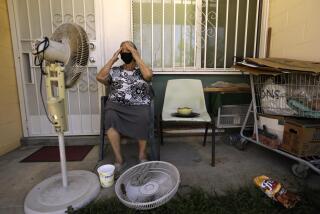Radiant Barrier in Attic Spells Comfort Below
- Share via
QUESTION: Will stapling inexpensive aluminum foil under the roof rafters really reduce the heat inside my house? I feel a lot of heat coming through the ceiling in the afternoon and evening.
ANSWER: Installing a radiant barrier (foil) in your attic can dramatically lower your air-conditioning bills and improve your comfort. You can easily install it yourself in a few hours with common hand tools.
Even if you use the air conditioning seldom or not at all, a radiant barrier can greatly improve your comfort level, especially in second-floor bedrooms. During mildly hot weather, attic radiant barriers can reduce the heat enough that you may not need to operate your air conditioner at all.
A radiant barrier is a material that blocks radiant heat energy. This is the kind of heat that is created when the sun shines on your roof. Your roof can reach 150 degrees or more. Without a radiant barrier foil, this heat radiates down to the attic insulation and through to your ceiling.
Aluminum foil has the radiant barrier properties of high reflectivity and low emissivity. This means that the foil reflects much of the roof’s heat back upward. The low emissivity property of the foil reduces the amount of heat that the foil radiates on through to the attic insulation below.
There are special inexpensive aluminum foil materials available for attic radiant barriers. Although almost any heavy-duty foil would be effective, foils reinforced with fibers or paper are more durable. They are also much easier to handle and staple in position.
The best location for a foil radiant barrier to be attached is the bottom edge of the roof rafters. This provides the necessary air gap above and below it for maximum energy efficiency. It also minimizes the buildup of dust on the foil which can reduce its effectiveness.
You can usually purchase the radiant barrier foil in four- or five-foot wide rolls. You just staple it up under the rafters. The neatness of the job is not as critical as with installing insulation. You can install it very quickly without sacrificing efficiency.
For the greatest reduction in the heat from your roof, make sure you also have adequate attic ventilation. A combination of ridge and soffit vents is best. This creates air flow between the foil and the underside of the roof. Therefore, the heat blocked and trapped by the foil is carried up and out the ridge vents at the roof peak.
You can write to me at the address below for Utility Bills Update No. 249 showing a list of addresses and telephone numbers of 15 manufacturers of radiant barrier foils, a small sample piece and do-it-yourself instructions and diagrams for installing foil. Please include $1 and a self-addressed stamped business-size envelope.
Lighter-Colored Roof Saves Energy, Shingles
Q: I am having new shingles put on my house and I was wondering if lighter-colored shingles will reduce the heat indoors. I have more than enough attic ventilation area.
A: Adequate attic ventilation area significantly reduces the heat buildup in an attic. However, even with the air flow through your attic, the roof still gets very hot in the sun. The hot underside of the roof radiates this heat down through the insulation to your rooms below.
A lighter-colored roof reduces the heat gain and results in a lower roof temperature. In addition to saving energy, a lower roof temperature extends the life of the shingles and the roofing structural lumber.
Return Air Registers Only Matter of Looks
Q: The slots in the return air register grills appear to be directional. They would direct air, blowing out of them, downward. Is that the correct direction for air conditioning or should I reverse them?
A: There really is no correct orientation for the direction of the slots in a return air register. Since it draws air in, the direction of the slots make very little difference in the air flow patterns. If the air were blowing out of them, then the direction would make a difference.
You should position the orientation of grill slots to get the best appearance. This usually means turning them so you don’t see through the slots into the duct.
More to Read
Sign up for Essential California
The most important California stories and recommendations in your inbox every morning.
You may occasionally receive promotional content from the Los Angeles Times.






